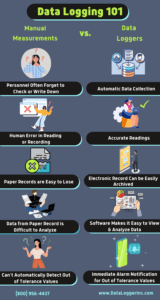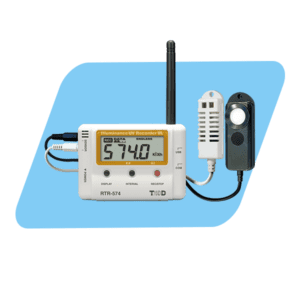Getting Started with Data Collection
Do you need a way to capture important information such as temperature, pressure, or voltage but don’t know how to get started? The Application Engineers at CAS DataLoggers have put together this brief Data Logging 101 overview to help guide you through the basics of data loggers and how they can simplify data collection for your organization.
What is a Data Logger?
A data logger, or datalogger, is an electronic device designed to measure and store data values, often independently of a PC. Nowadays most data loggers are compact and relatively inexpensive. Dataloggers may be single-input devices or may accept inputs from multiple types of sensors. Some loggers have built-in sensors and others have connections to external sensors. Data loggers have internal memory, a real-time clock for time/date stamps, and may have an LCD display. A datalogger typically has an internal battery and records at a once-per-second or slower sample rate with internal memory for thousands or millions of readings.
A device like a simple temperature and humidity data logger may be located at the point of interest for the measurement and retrieved at a later date to unload the data using a USB connection. A more sophisticated datalogger may have Ethernet, WiFi, or even a cellular modem which allows for real-time monitoring and alerting for out-of-tolerance (alarm) conditions. This feature will let you take immediate action to out-of-limit conditions instead of just collecting or logging the data. With network-connected dataloggers, fully automated data transfer to network drives or even cloud-based applications provide labor savings and convenience. Data loggers are much more reliable and accurate than manual measurements and free up labor for other duties.
Advantages of a Data Logging:
Data loggers provide several advantages in reliability, accuracy, and cost over manual measurements:

Being more reliable and accurate than manual measurements, data loggers save personnel the time otherwise spent taking down reading and recording measurements on paper. Whether you have a short- or long-term problem to solve, data loggers give you an automated solution for both monitoring and recording information.
As mentioned before, data loggers can even transmit alarms via email, text messages, or trigger phone calls! This feature is important if you need to be alerted on a business-critical piece of equipment, process (assembly line, boiler tank, etc.), or environment going out of tolerance. This can help you to avoid a potentially-disastrous process delay, shutdown, or material loss!
Data loggers can also operate ‘standalone,’ i.e. by themselves without human interaction, so they make a great solution for businesses and healthcare centers. Running on battery power, they can be used over long periods of time in many different applications.
Why Use Data Logging?
 A typical application for a datalogger is to record and monitor the temperature of a specific product or environment, like a vaccine storage refrigerator. The data logger will operate 24/7 including the weekends, holidays, or outside of work hours when no person is available for the task. Data loggers are also used for more complex tasks such as recording multiple sensor data from machines for diagnostic purposes or to identify areas for energy savings.
A typical application for a datalogger is to record and monitor the temperature of a specific product or environment, like a vaccine storage refrigerator. The data logger will operate 24/7 including the weekends, holidays, or outside of work hours when no person is available for the task. Data loggers are also used for more complex tasks such as recording multiple sensor data from machines for diagnostic purposes or to identify areas for energy savings.
Another major reason to use a data logger is to comply with regulatory agency requirements, whether it’s the FDA’s FSMA, VFC, HACCP for best practices, or another mandate. Data loggers document product temperature data for use in electronic documentation, proving to inspectors and auditors that your product and/or environment were kept within safe parameters.
What Do You Need to Measure?
Now ask yourself, “What type of data do I need to measure?”
Most commonly, the answer is temperature, but what if you need to also log humidity, or what if you need to log both temperature and carbon dioxide levels? Fortunately, there are a wide variety of devices on the market with internal or external sensors to measure the data you need. Also, for some applications, it is important to know the measurement accuracy that is required. For example, monitoring vaccines requires a recommended accuracy of +/- 0.5 °C/1.0°F or better.
While some data logger models are designed to log just one measurement value such as temperature, there are models recording two, three, or more types of data. For example, at CAS DataLoggers we offer data loggers for the following types of signal inputs: Temperature, Relative Humidity, Voltage, Process (4-20mA) Current, Pressure, Pulse Count/Event/State, Frequency, Sensors with Serial Output (RS-232, Modbus, SDI-12) and more.
Easy Data Retrieval:
 Typically, data loggers save their measurements to a memory card or other internal memory for convenient retrieval. More advanced models can also transfer the data automatically over your choice of communications. These include but are not limited to:
Typically, data loggers save their measurements to a memory card or other internal memory for convenient retrieval. More advanced models can also transfer the data automatically over your choice of communications. These include but are not limited to:
- Ethernet
- WiFi
- Cellular Modem
- Proprietary Wireless
- Bluetooth
How Do I Set Alarms?
Today’s technology gives you several choices of how you’d prefer to receive alarms. For example, alarm notifications can consist of anything from bright LED indicators and loud audible alerts to data loggers with external alarm outputs for connection to sirens, lights, etc. More advanced models can automatically send you an email or text alarm to your smartphone or tablet, ensuring that you’re always notified of critical changes in your product or process. Alarm setup and other configuration details are handled using software provided by the data logger.
So…How Technical Do I Need to Be?
Good news—most data loggers are easy to use!
Very simple loggers such as shipping temperature loggers come preprogrammed; simply push a button or remove a pull tape to start logging. Other data loggers that offer changeable settings typically use Windows-based software to handle setup and configuration. Simply connect your data logger to a PC, follow the simple configuration wizard, and pick your recording rate and start time—all this normally just takes a few mouse clicks.
The latest generation of data loggers provides simple connectivity to cloud-based applications to view and store data. Simply configure the logger to connect to your network, Ethernet or WiFi, open a web browser to access your cloud account, and get your data. You can be up and running in just a few minutes. Being designed for simple operation, many compact data loggers require minimal to no maintenance or IT department involvement. That makes them ideal for use in nearly every industry and application.
The Data Logging Experts:
When searching online for the right data logger, you want to be confident that the device itself can perform the functions you need for your particular application. It is important to work with a vendor that knows the right questions to ask to make sure that the product you end up with fits your needs.
This includes (but is not limited to) the right number of channels/inputs to cover all your monitoring points, communication options, and software features. For example, if you need alarming capabilities or a trend chart for data or if you need to comply with some special regulatory or calibration requirements, make sure you specify this when speaking with a solutions provider.
You’ll find lots of data logger manufacturers and distributors online, so make sure you consult with an experienced distributor. While data loggers are easy to use, you won’t get stuck if there’s a free technical support number you can call if you run into a problem, especially if you’re a first-time user.
To browse our extensive inventory of data loggers, or to find the ideal solution for your application-specific needs, contact a CAS DataLoggers Application Specialist at (800) 956-4437 or request more information.

